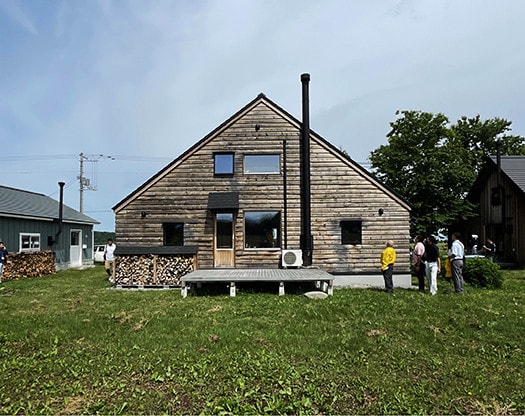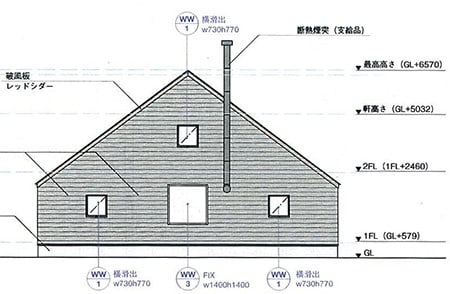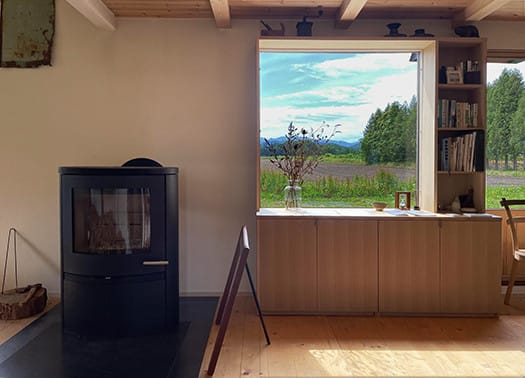


昨日は久しぶりにわたしに出張取材の役回りが回ってきました。年に1度の新住協北海道の例会で、前半は住宅建築実例見学が3件で後半には事例報告と鎌田紀彦先生による講演という日程。前日から旭川に多くのメンバーが集結しているようでしたがわたしは日程的に難しく、当日往復というハードなスケジュール設定。
なんですが、古くからのメンバーのみなさんや鎌田先生とも交流ができていろいろ情報交換することができました。それになによりすっかりご無沙汰している「住宅取材」の機会が得られたことで、なにかストレスがきれいに洗い落とされていくような清々しさを感じ続けておりました。やっぱ、家づくりの現場はいい。
写真は近年北海道でも有数の「人口増加」傾向にある旭川近郊の東川町の現場であります。ちなみに3件とも東川町ということで、同町がいかに活発な建築需要であるかがわかりますね。北海道全体では直近の人口は5,149,405人ということで人口は1997年の約570 万人をピークに全国より約10年早く人口減少局面に突入しています。まことに「課題の最先端地域・北海道」ということが言えるでしょう。
そのなかでしかし、しっかりした「地域戦略」に沿って努力し続けている地域は活発な経済活動が行われている。ニセコ地域とか、富良野地域、そしてこの東川地域などは好例と言えるでしょう。
おっと、住宅実例取材としてはやや横道気味(笑)。この家は十勝地域から移住してきて建築設計アトリエを営まれている「モノクラフト」という屋号の清水徹さんのショールーム・工房。住宅棟は隣接して建てられていて今回そちらは断熱改修されたのですが、同時にこちらは設計の工房として新築した建物。
のどかな自然が広がる敷地を背景に、いかにもシンプルな三角屋根の外観が美しい。資材高騰という現実の中で面積は抑えていてコンパクトだけれど、木製窓とか、外装には北海道地元産のトドマツ(18mm厚)を張っていて目に自然な景観を生み出している。
北海道の自然に抱かれてシンプルに暮らしたいという希望を持つとすれば、たぶん多くのみなさんがこういった暮らしのイレモノを希望するのではないか、そういった感覚をそのまま表現している。豊かな自然環境の中では外観形状もゴテゴテとした形態ではなく、これでどうだというような率直さが胸に響いてくる。三角屋根のシンプルさは、人間の暮らしを守る屋根が主役のデザインで、人類普遍的。
そういうシンプルデザインが地域の中に多数存在することで、地域らしさをメッセージすると思われます。人口減少期ではあっても逆に日本全体、世界に対してアピールするポイントでしょうね。この項、明日に続きます。
English version⬇
Atelier Architecture in Higashikawa Town, Hokkaido
There is something about a fresh sense of "residential coverage" that revives my senses in a deep way. A simple triangular roof in a rich natural environment. The sense of human life. The house is a simple triangular roof in a rich natural environment.
Yesterday, for the first time in a while, I was assigned to cover a business trip. The first half of the meeting consisted of three tours of actual housing construction, and the second half consisted of case reports and a lecture by Mr. Norihiko Kamata. Many members seemed to have gathered in Asahikawa the day before, but it was too difficult for me to make the round trip on the day of the meeting.
However, I was able to meet with many of the old members and Dr. Kamata and exchange information. More importantly, I was able to have the opportunity to do "housing interviews," something I have not done for a long time, and I kept feeling refreshed, as if all my stresses were being washed away. I knew it was good to be at a house-building site.
The photo shows a site in Higashikawa, a suburb of Asahikawa, which has been experiencing one of the largest "population growth" trends in Hokkaido in recent years. All three of the sites are in Higashikawa, which shows how active the demand for construction is in the town. The population of Hokkaido as a whole peaked at 5,149,405 in 1997, about 5.7 million, and has entered a phase of population decline about 10 years earlier than the rest of Japan. Hokkaido is truly a "region at the forefront of issues.
However, those regions that continue to make efforts in accordance with a solid "regional strategy" are experiencing active economic activities. The Niseko area, Furano area, and the Higashikawa area are good examples.
Oops, this is a bit of a side-track for a housing case study (lol). This house is the showroom/workshop of Toru Shimizu, who moved from the Tokachi area and runs an architectural design studio under the name "Monocraft. The house was built adjacent to a residential building, which was renovated and insulated, and this building was newly constructed as a design studio.
The exterior of the building, with its simple triangular roof, is beautiful against the backdrop of the tranquil natural surroundings. The wooden windows and the exterior made of Abies sachalinensis (18mm thick), which is locally grown in Hokkaido, create a natural landscape to the eye.
If one were to wish to live a simple life in the embrace of Hokkaido's nature, many people would probably wish for this kind of lifestyle, and this house expresses such a feeling. In this rich natural environment, the exterior shape of the house is not overly elaborate, and the frankness with which it is presented resonates in the hearts of the residents. The simplicity of the triangular roof is a design in which the roof plays a leading role in protecting human life, and is universal to mankind.
The presence of many such simple designs in a region is thought to send a message of regional character. Even in a time of declining population, this would be a point of appeal to Japan as a whole and to the world. This section will be continued tomorrow.










